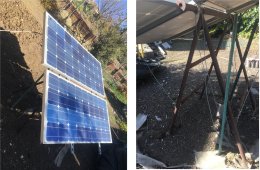Warpspeed
Solar Wizard
That is a very neat and clever job.
Well done !
Well done !
Very cool.Here's mine
I'm getting ready to expand it to two 435w panels
Very cool.
Did you try the diodes and multiple panels yet ?
Diodes came on each of my psnels, are there more that I should know about?
I like the bevel.
I like the bevel.
I was thinking about the hinge travel on each side and how to evenly split it in half.
The support board lengths could probably also be split in half to balance the weight (if they aren't already).
Is there any advantage to having the smaller panels on the ends of the larger panel or formed as a pyramid on a single mount on the fulcrum point ? The wires could be shorter but the fulcrum would need to be longer.
Any thoughts on wind resistance ?
Here's mine! made out of 2 pallets, wheels from amazon, timber is 38x63mm stud planks, with single slot shelving bars as axles! Bit of strapping screwed underneath, so I can lift and move them around the garden (there are 2 of them).

If both sides are equally weighted and spaced, having them on the ends should not give a mechanical advantage. Moving the actuator further away from the fulcrum would give an mechanical advantage at the expense of increased travel....
That's an interesting thought, hmm. Yeah I guess it would not matter if they form a pyramid off to the right or left side.
One thing they do on the ends is they act as a counterbalance providing leverage to help the actuator lift the panels out of the far west/east 30 degree position
...
If both sides are equally weighted and spaced, having them on the ends should not give a mechanical advantage. Moving the actuator further away from the fulcrum would give an mechanical advantage at the expense of increased travel.
UPDATE: I see the way that you have them mounted, the high side extends further out and the low side tucks in so it does give a mechanical advantage.
Moving the small panels to the center would take some stress/flex off the panels though.
As for counterbalance, maybe a T in the center ? The weight on the bottom leg of the T would assist in uprighting the T and returning the panels flat similar to a pencil fishing bobber up righting itself.
That was always a big concern for me. My solution was to place trusses on the back side of each solar frame to control flexing in the Z dimension. I also control flexing in the X/Y dimensions via diagonal support members and rebar.Moving the small panels to the center would take some stress/flex off the panels though.
For whatever reason, the software is not allowing me to post the pic of this? Sorry!
Thanks for the update, especially pointing out the operational details ?Full video of my updated tracker
Thanks for the update, especially pointing out the operational details ?
Do you think the hinge friction is from the hinges bending against the pins, adjacent hinges being out of alignment (actuator on on side vs center) with each other and/or hinge ends rubbing against the wood ? If it is rubbing against the wood, that could be remedied fairly easily.
Did you lubricate the hinge pins ?
Would moving the actuator to the center help even out the applied force (minimize/equalize the torsion force across the 3 hinges) ? With the actuator on the side, the torsion force on all 3 hinges is different. Moving it to the center makes the center hinge "flat" and the 2 outside hinges having half, but equal twist (in opposite directions).
Do you have any feedback on how much performance improvements the tracker adds ?
Also, I know shorting AC hot and neutral creates some exciting results but what does connecting apposing DC do ? Does it affect the panels ?
About how many hours are you getting at that rate ?Not much yet. I do have it tied to my charge controller in my crypto shed. I roughly monitored throughout the day yesterday but it was constantly outputting around 650-700w from the time it first flipped to the east until the panel began getting shaded on the west.
About how many hours are you getting at that rate ?
Has it extended the peak rate for your location ?
TIA


